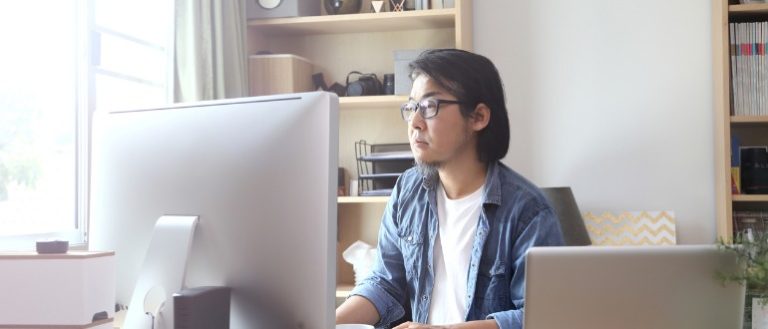5 Questions That Will Help You Design a Home Office

You’re ready to design your perfect home office. Maybe you just started a new job where you’ll be able to telecommute regularly. Or perhaps you’ve decided to take the plunge and start your own business or freelance career. Whatever the reason, creating the right kind of space can reduce distractions, boost productivity, and decrease stress. Here are five questions to ask yourself when setting up or redesigning your home office.
1. How will you use your office?
Knowing how you plan on using your office is crucial to designing one that works for your needs.
- Are you running your own business?
- How many days of the week will you use your office?
- Do you have a side hustle?
- Are you a freelancer?
- How many hours a day will you use your office?
- Are you paperless or do you need file storage?
- Will you be sharing your office with a partner or your family?
Look for inspiration once you know what your needs are. Pinterest and office design magazines may provide some ideas, but remember to prioritize functionality. You don’t want to purchase an aesthetically pleasing desk that doesn’t have the space you need to get work done. You may also want to complement your home’s existing decor.
2. Where will your work space be?
Use as much space as you can allocate. For example, don’t leave the rarely-used guest room vacant while you cram your setup into a dark corner of the living room. You can always invest in a murphy or sofa bed if you’re concerned about having both a functional office space and guest room.
Chances are, you have found yourself wishing for more natural light if you’ve ever worked (or still work) in a traditional office. By working from home, you can take advantage of the natural light your average cubicle doesn’t offer. Facing your desk towards a window gives you great lighting without a glare.
3. What do you have and what do you need?
Make a list of office supplies and furniture you already have and what you’d like to add. Include a price estimate next to each item. You can take this one step further and prioritize your list so you purchase the important things first.
Don’t forget to list intangible things like accounting software, business internet, and virus protection you may need to purchase or upgrade.
Next, measure the room or space and any office furniture you already have. Write your measurements down and refer to them while shopping—you don’t want to finish setting up your new desk only to realize it won’t work.
4. What do you need out of your desk and chair?
Splurge on your office desk and chair—you’re going to be spending most of your day using them. With a home office space you’re free to choose from endless types of office chairs and desks. Do some research to pick the best options for your space and your health.
You may have heard sitting is the new smoking. Standing desks are becoming a popular way to combat the health risks of prolonged sitting. That’s why we recommend an adjustable desk. You’ll get the benefits of standing, yet you can still sit when your legs get tired. There are also tabletop options that convert an existing traditional or built-in desk into a standing workstation. You can also invest in an exercise desk if you have the space for it.
You may decide to forgo the office chair completely if you get a standing desk. However, you’ll definitely want a chair with a traditional desk. Some options you should consider include ergonomic chairs, stools that align your spine, and balance ball chairs that strengthen your core.
5. How much storage do you need?
Filing systems don’t have to be ugly. Skip the metal filing cabinet by planning your storage space ahead of time. A proper filing system can help you keep track of your receipts, which can save your hundreds with tax deductions.
There are several creative ways to incorporate storage:
- Take advantage of wasted wall space with hanging storage.
- Add drawers to a window seat if you have plenty of room.
- Look for a desk with plenty of drawers if you want everything within arm’s reach.
- Use a bookshelf with decorative baskets.
- Check out antique shops and thrift stores for unique finds.
- Switch to filing binders for each quarter or year.
Designing a home office can either be exciting or stressful. Either way, a little planning can go a long way in creating a space where you can focus. A properly designed home office might even become your favorite room in the house.



